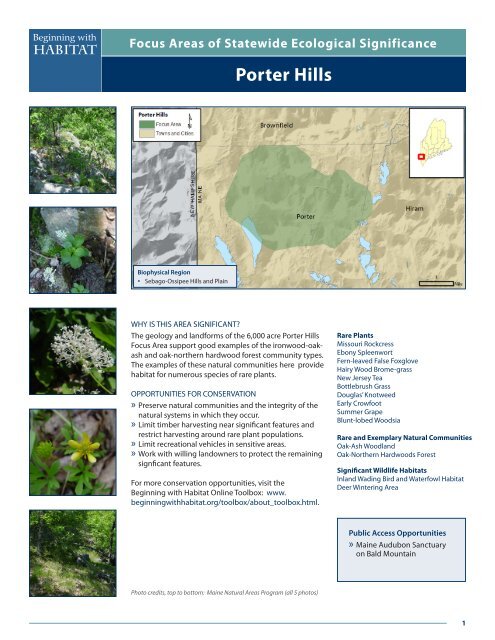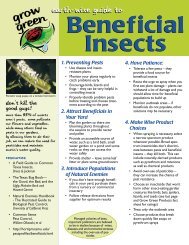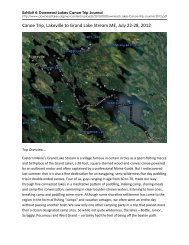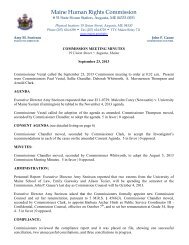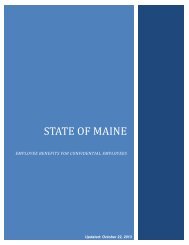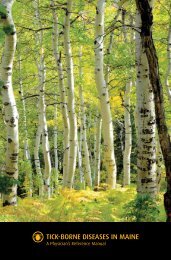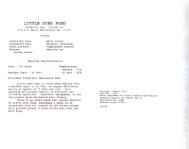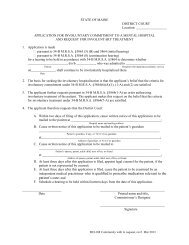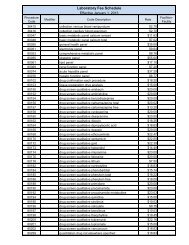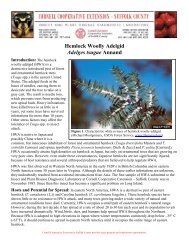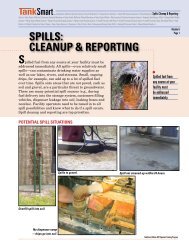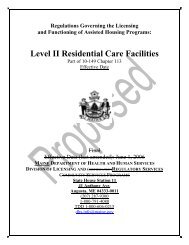PDF-2 MB - Maine.gov
PDF-2 MB - Maine.gov
PDF-2 MB - Maine.gov
You also want an ePaper? Increase the reach of your titles
YUMPU automatically turns print PDFs into web optimized ePapers that Google loves.
Beginning with<br />
Focus Areas of Statewide Ecological Significance: Porter Hills<br />
Habitat<br />
Focus Areas of Statewide Ecological Significance<br />
Porter Hills<br />
Biophysical Region<br />
• Sebago-Ossipee Hills and Plain<br />
WHY IS THIS AREA SIGNIFICANT?<br />
The geology and landforms of the 6,000 acre Porter Hills<br />
Focus Area support good examples of the ironwood-oakash<br />
and oak-northern hardwood forest community types.<br />
The examples of these natural communities here provide<br />
habitat for numerous species of rare plants.<br />
OPPORTUNITIES FOR CONSERVATION<br />
»»<br />
Preserve natural communities and the integrity of the<br />
natural systems in which they occur.<br />
»»<br />
Limit timber harvesting near significant features and<br />
restrict harvesting around rare plant populations.<br />
»»<br />
Limit recreational vehicles in sensitive areas.<br />
»»<br />
Work with willing landowners to protect the remaining<br />
signficant features.<br />
For more conservation opportunities, visit the<br />
Beginning with Habitat Online Toolbox: www.<br />
beginningwithhabitat.org/toolbox/about_toolbox.html.<br />
Rare Plants<br />
Missouri Rockcress<br />
Ebony Spleenwort<br />
Fern-leaved False Foxglove<br />
Hairy Wood Brome-grass<br />
New Jersey Tea<br />
Bottlebrush Grass<br />
Douglas’ Knotweed<br />
Early Crowfoot<br />
Summer Grape<br />
Blunt-lobed Woodsia<br />
Rare and Exemplary Natural Communities<br />
Oak-Ash Woodland<br />
Oak-Northern Hardwoods Forest<br />
Significant Wildlife Habitats<br />
Inland Wading Bird and Waterfowl Habitat<br />
Deer Wintering Area<br />
Public Access Opportunities<br />
»»<br />
<strong>Maine</strong> Audubon Sanctuary<br />
on Bald Mountain<br />
Photo credits, top to bottom: <strong>Maine</strong> Natural Areas Program (all 5 photos)<br />
1
Focus Areas of Statewide Ecological Significance: Porter Hills<br />
Ironwood - Oak - Ash Woodland, <strong>Maine</strong> Natural Areas Program<br />
FOCUS AREA OVERVIEW<br />
The Porter Hills Focus Area covers approximately 6,000 acres<br />
and includes a series of low mountains and rolling forested<br />
hills. The geology and land forms of this site create conditions<br />
that support numerous rare plants as well as several good<br />
quality examples of the ironwood – oak – ash woodland natural<br />
community type. Ironwood – oak – ash woodland natural<br />
communities, along with habitat for many of the rare plants,<br />
occur on the upper portions of steep, south facing slopes on<br />
several of the mountains. Sections of these steep slopes have<br />
calcium enriched rock outcrops near their summits and talus<br />
scattered on the slopes below. Ironwood – oak – ash woodlands<br />
typically have open canopies that allow an abundance of<br />
light to reach the understory and ground layer.<br />
Ironwood (Ostrya virginiana) and red oak (Quercus rubra) are<br />
the most common trees with white ash (Fraxinus americana),<br />
basswood (Tilia americana), sugar maple (Acer saccharum),<br />
white pine (Pinus strobus), and red cedar (Juniperus virginiana)<br />
all as infrequent associates. Poor growing conditions due to<br />
droughty soils or possibly past fires have helped to keep the<br />
trees in this habitat type spread out and stunted. The herb<br />
layer features plant species typical of moderately enriched<br />
sites, such as herb Robert (Geranium robertianum), hepatica<br />
(Hepatica americana), and wild licorice (Galium lanceolatum).<br />
Vegetation may be patchy, developing in pockets among the<br />
rocks, or more continuous along upper slopes and ridges. In<br />
general, these natural communities have not been harvested<br />
for timber, most likely due to the poor quality of the trees and/<br />
or the steepness of slopes where they occur.<br />
A good quality example of a red oak – northern hardwood –<br />
white pine forest has also been documented within this area.<br />
This community is an upland type dominated by a mix of red<br />
oak, northern hardwoods, and sometimes conifers. Red oak<br />
is usually most common and northern hardwoods (typically<br />
beech (Fagus grandifolia)) are subordinate. Mixed stands have<br />
white pine or red spruce (Picea rubens) as the main conifers.<br />
The lower layers are sparse, with tree regeneration typically<br />
higher in cover than forest herbs. These types are found on<br />
well drained loamy soils on mid - to lower slopes that are not<br />
very exposed.<br />
The Porter Hills Focus Area includes diverse fishery resources.<br />
Colcord Pond is managed for coldwater species and includes<br />
a self-reproducing population of lake trout. The Ten Mile River<br />
Watershed supports an excellent wild brook trout population<br />
and is also stocked with Atlantic salmon.<br />
2
Focus Areas of Statewide Ecological Significance: Porter Hills<br />
Many rare plants species including Missouri rock cress (Arabis<br />
missouriensis), ebony spleenwort (Asplenium platyneuron),<br />
Douglas’ knotweed (Polygonum douglasii), blunt-lobed<br />
woodsia (Woodsia obtusa), early crowfoot (Ranunculus fascicularis),<br />
and fern-leaved false foxglove (Aureolaria pedicularia)<br />
are found growing on the upper slopes of these hills. Down<br />
slope, where the canopy is thicker and the trees are taller,<br />
sugar maple, basswood, and white ash are common at several<br />
sites, and other rare plants such as bottlebrush grass (Elymus<br />
hystrix) and hairy wood brome-grass (Bromus pubescens) also<br />
occur. Most of these species are at the northern edge of their<br />
ranges in southern <strong>Maine</strong>.<br />
CONSERVATION CONSIDERATIONS<br />
»»<br />
Preserving Natural Communities: Preserving natural communities<br />
and other sensitive features will be best achieved<br />
by conserving the integrity of the larger natural systems in<br />
which these features occur. Conserving the larger systems<br />
helps ensure both common and rare natural features will<br />
persist in this part of the state.<br />
»»<br />
Set Asides: Conservation planning for upland features<br />
should include setting some areas aside from timber harvests<br />
to allow for the development of some unmanaged<br />
forests.<br />
»»<br />
Vernal Pools: Close adherence to Best Management Practices<br />
for forestry activities near vernal pools (available from <strong>Maine</strong><br />
Audubon Society at 207-781-6180 ext. 222 or bwilson@<br />
maineaudubon.org) will ensure the protection of wetlands<br />
and the amphibian food source they supply.<br />
»»<br />
Off Road Vehicle Use: No ATV access should be permitted<br />
on the summits and upper slopes of the mountains.<br />
»»<br />
Ironwood – Oak – Ash Woodlands rare plant populations will<br />
be best maintained by leaving them undisturbed. Timber<br />
harvesting that excludes buffered sensitive areas should be<br />
compatible with the long-term persistence of these features.<br />
Intact forest buffers of 250 feet or more should be maintained<br />
around known concentrations of rare plants.<br />
»»<br />
Invasive Species: Invasive plants and aquatic organisms<br />
have become an increasing problem in <strong>Maine</strong> and a threat<br />
to the state’s natural communities. Disturbances to soils and<br />
natural vegetation and introductions of non-native species<br />
to terrestrial and aquatic habitats can create opportunities<br />
for colonization. Landowners and local conservation groups<br />
should be made aware of the potential threat of invasive<br />
species, of methods to limit establishment, and/or of appropriate<br />
techniques for removal. For more information on<br />
Ecological Services of the Focus Area<br />
• Supports habitat for diverse species of<br />
wildlife<br />
• Contributes to regional biodiversity<br />
by providing habitat to both rare and<br />
common species<br />
• Purifies run off<br />
Economic Contributions of the Focus Area<br />
• Provides forest products<br />
• Provides recreational opportunities<br />
including hiking, hunting and fishing<br />
invasive plants visit: http://www.maine.<strong>gov</strong>/doc/nrimc/<br />
mnap/features/invasives.htm.<br />
»»<br />
Habitat Connections: With expected changes in climate over<br />
the next century, plant and wildlife species will shift their<br />
ranges. Maintaining landscape connections between undeveloped<br />
habitats will provide an important safety net for<br />
biodiversity as species adjust their ranges to future climate<br />
conditions.<br />
Missouri Rockcress, <strong>Maine</strong> Natural Areas Program<br />
For more information about Focus Areas of Statewide Ecological Significance,<br />
including a list of Focus Areas and an explanation of selection criteria, visit<br />
www.beginningwithhabitat.org<br />
3
Focus Areas of Statewide Ecological Significance: Porter Hills<br />
RARE SPECIES AND EXEMPLARY NATURAL COMMUNITIES OF THE FOCUS AREA<br />
Common Name<br />
Scientific Name<br />
State<br />
Status*<br />
State<br />
Rarity<br />
Rank<br />
Global<br />
Rarity<br />
Rank<br />
Missouri Rockcress Arabis missouriensis T S1 G5?Q<br />
Ebony Spleenwort Asplenium platyneuron SC S2 G5<br />
Fern-leaved False Foxglove Aureolaria pedicularia SC S3 G5<br />
Hairy Wood Brome-grass Bromus pubescens PE S2 G5<br />
Plants<br />
New Jersey Tea Ceanothus americanus T S1S2 G5<br />
Bottlebrush Grass Elymus hystrix SC S3 G5<br />
Douglas’ Knotweed Polygonum douglasii T S2 G5<br />
Early Crowfoot Ranunculus fascicularis T S1 G5<br />
Summer Grape Vitis aestivalis T S2 G5T5<br />
Blunt-lobed Woodsia Woodsia obtusa T S1 G5<br />
Natural<br />
Communities<br />
Oak-Ash Woodland Ironwood – Oak - Ash Woodland S3 G3G5<br />
Oak - Northern Hardwood<br />
Forest<br />
Red Oak - Northern Hardwoods- White Pine Forest S4 GNR<br />
State Status*<br />
E<br />
T<br />
SC<br />
Endangered: Rare and in danger of being lost from the state in the foreseeable future, or federally listed as Endangered.<br />
Threatened: Rare and, with further decline, could become endangered; or federally listed as Threatened.<br />
Special Concern: Rare in <strong>Maine</strong>, based on available information, but not sufficiently rare to be Threatened or Endangered.<br />
*State status rankings are not assigned to natural communities.<br />
State Rarity Rank<br />
S1<br />
S2<br />
S3<br />
S4<br />
S5<br />
Critically imperiled in <strong>Maine</strong> because of extreme rarity (5 or fewer occurrences or very few remaining individuals or acres).<br />
Imperiled in <strong>Maine</strong> because of rarity (6–20 occurrences or few remaining individuals or acres) or because of other factors<br />
making it vulnerable to further decline.<br />
Rare in <strong>Maine</strong> (on the order of 20–100 occurrences).<br />
Apparently secure in <strong>Maine</strong>.<br />
Demonstrably secure in <strong>Maine</strong>.<br />
Global Rarity Rank<br />
G1<br />
G2<br />
G3<br />
Critically imperiled globally because of extreme rarity (5 or fewer occurrences or very few remaining individuals or acres)<br />
or because some aspect of its biology makes it especially vulnerable to extirpation.<br />
Globally imperiled because of rarity (6–20 occurrences or few remaining individuals or acres) or because of other factors<br />
making it vulnerable to further decline.<br />
Globally rare (on the order of 20–100 occurrences).<br />
G4<br />
G5<br />
Apparently secure globally.<br />
Demonstrably secure globally.<br />
4


